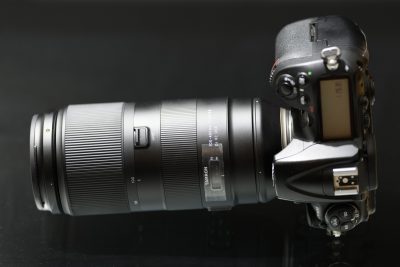Tamron 100-400mm VC review
-
-
Written by Thomas
In depth
The Tamron 100-400/4.5-6.3 VC is a long telephoto zoom that’s corrected for full-frame sensors and available in Canon and Nikon DSLR mounts.
Announced in October 2017 it is the first lens of this focal range from Tamron and it comes hot on the heels of Sigma’s 100-400/5-6.3 OS Contemporary that was released six months earlier. As you would expect from any new Tamron lens it is compatible with their USB-dock (dubbed “Tap-in console”) to fine tune various characteristics of AF and image stabilization. And this all comes at a low price: for 800 USD / 870 EUR it is one of the most affordable of any modern zooms reaching 400mm focal length.
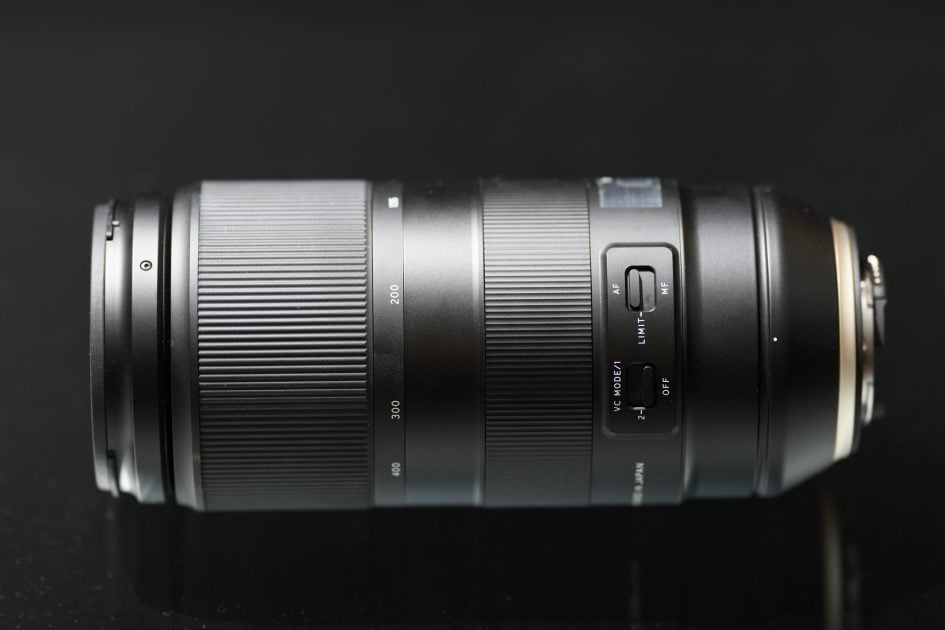
Facts from the catalog
As usual I’ll have a look at the technical data of the Tamron first. I’ve rated the features with a [+] (or [++]), when it’s better than average or even state of the art, a [0] if it’s standard or just average, and [-] if there’s a disadvantage. For comparison I use the Sigma 100-400/5-6.3 OS (“Sigma” for short), the Nikon 80-400/4.5-5.6G VR (“Nikon”) and the Canon EF 100-400/4.5-5.6 L IS II (“Canon”).
Size (diameter x length): 86x197mm (3.4×7.8in.), the lens hood adds 63mm (with a diameter of 98mm) . Zooming in adds another 70mm which gives a total maximum length of 330mm. The zoom can be locked at 100mm. The Sigma is only 182mm long (+ 60mm for the lens hood and 60mm for zooming in), the Nikon is 96x204mm with the lens hood and zoom adding another 86+56mm to a total maximal length of 346mm. The Canon is 94mm in diameter and 193mm long (w/o lens hood and at 100mm focal length). [0]
Weight: 1108g (39oz.) plus 54g for the plastic lens hood. The Arca-Swiss compatible tripod collar is sold separately and adds 144g. The Sigma weighs 1147g plus 66g for the lens hood (no tripod collar available for the Sigma), the Nikon is 1471g (w/o tripod collar of 93g) the lens hood adding another 95g. The Canon is around 1570g (incl. tripod collar but w/o lens hood). So the new Tamron is the lightest zoom reaching 400mm focal length. [+]
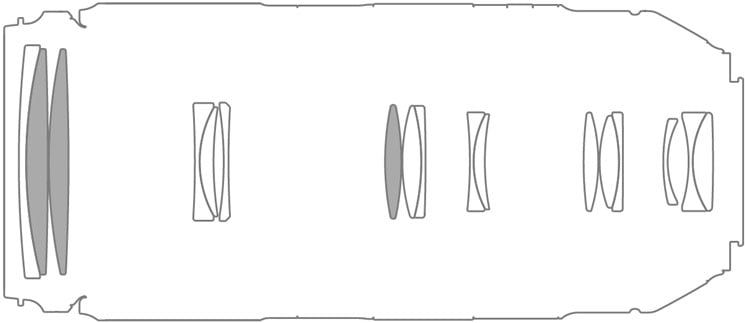
Optics: 17 elements (including 3 low dispersion elements) in 11 groups. The competition has 20-21 elements in 12-16 groups. So the new Tamron has the simplest optical design with the least number of air/glass surfaces which might make it less prone to flare and glare. Its front lens has fluorine coating to repel water, dust, and dirt. It is compatible with Tamron’s 1.4x tele-converter. [+]
Closest focus distance officially is 1.5m (4.9ft.) with a magnification of 1:3.6 although I was able to get down to 1:3.0 at 1.3m with manual focus. This is a very usable magnification even better than the 1:3.4 from the Sigma. The Nikon does only 1:5 at 1.5m in manual focus. The Canon goes much closer to 0.98m and offers a magnification of 1:3.2. [+]
Focal ratio: the maximum aperture is reduced when the lens is zoomed in. It is f/4.5 only up to 112mm focal length, f4.8 up to 135mm, f/5.0 up to 160mm, f5.3 up to 195mm, f/5.6 up to 240mm, f6.0 up to 300mm and f/6.3 beyond that. The Sigma is f/5.0 up to 120mm, f/5.3 up to 150mm, f/5.6 up to 220mm, f6.0 up to 340mm and f/6.3 beyond that. Focal ratios smaller than f/5.6 might not work too well with focus points outside the central one on some (older) cameras. The Nikon has the following focal ratios: f/4.5 up to 95mm, f/4.8 up to 130mm, f/5.0 up to 175mm, f/5.3 up to 240mm and f/5.6 beyond that. [0]
Filter-thread: 67mm, like the Sigma. The Nikon and Canon take 77mm filters, the professional standard. [0]
Image stabilization: Yes, just like the competition. This is indispensable when handholding at long focal lengths. VC mode 1 is the normal operation while VC mode 2 is for panning. You can also customize VC operation via the Tap-in console to be more effective for stabilizing the view-finder and shooting video or for shooting stills. [+]
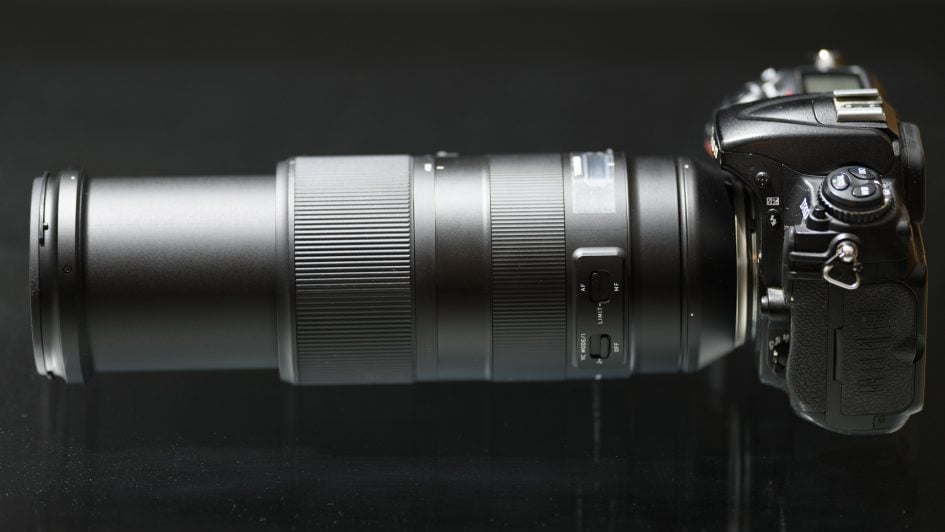
Auto focus: USD (Ultra Sonic Drive), so it also works on camera bodies which don’t have an AF-drive built in like Nikon’s D3x00/5×00. Manual-focus override is by simply turning the focus ring. Same with the competition. The new Tamron allows you to alter focus fine-tuning at 3 distances and 5 focal lengths with the TAP-in console. Plus its AF switch has a position that limits focus to 7m – infinity which is also configurable with the USB-dock (a.k.a. TAP-in console). [+]
Covers full frame/FX or smaller = very good. Same with the competition. [+]
Price: around 840 EUR (incl. 19% VAT) / 800 USD, the optional tripod collar adds 129 EUR/USD. The Sigma is 10% cheaper (750 EUR, no option for a tripod collar). And both the Nikon (2400 EUR) and the Canon (2000 EUR) are much more expensive but both include the tripod collar. [+]
Comes without lens pouch or strap. The lens hood is included, reversible for transport, and the lens-caps are standard. [0]
Distance information is relayed to the camera, so the camera and flashes can do all the advanced exposure-related stuff with this lens. Same for the competition. [+]
Aperture ring: no, same as with the competition. The aperture is actuated electromagnetically in the Nikon-version too which makes it the equivalent of a modern E-type Nikon lens and puts away with the mechanical coupling that Nikon uses on all older lenses. [0]
Sealing: yes, a rubber grommet at the lens-mount and at the front plus further special weather-sealing inside the lens. Both the Nikon and the Canon are similarly weather-proofed. Only the Sigma seems to rely solely on a rubber grommet at the lens mount. [+]
The score in the “features-department” is 0[-]/5[0]/9[+]. The major benefits are the low weight and the low price.
Three long telephoto lenses
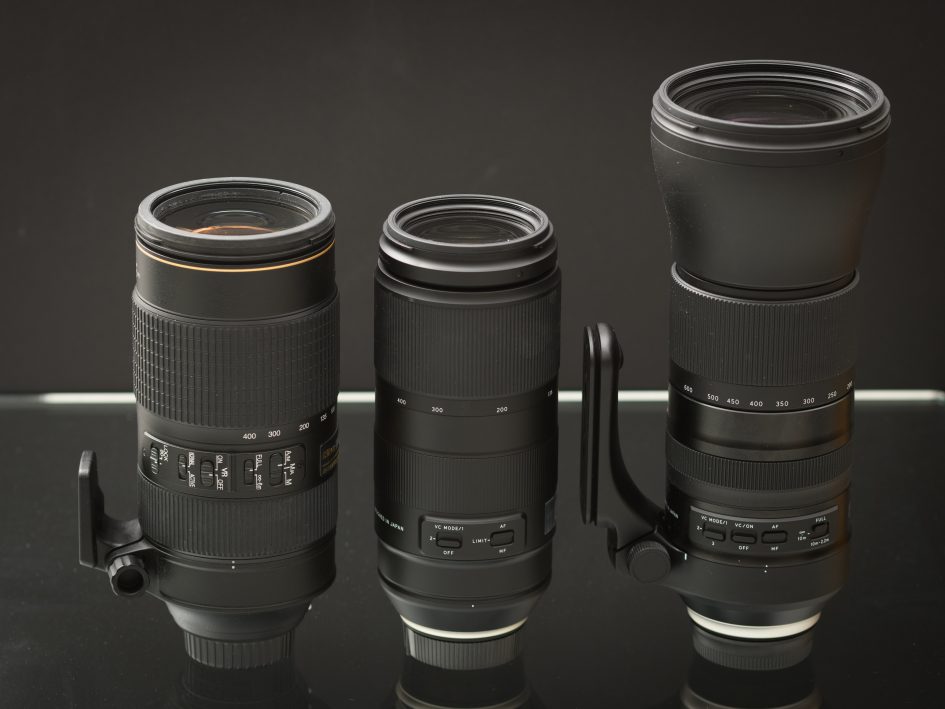
Above left to right: Nikon 80-400/4.5-5.6G VR, Tamron 100-400/4.5-6.3 VC, Tamron 150-600/5-6.3 VC
Alternatives:
- Sigma offers the 100-400/5.0-6.3 DG OS HSM Contemporary from 2017. The Sigma has the unique benefit that you can swap the lens mount between Nikon and Canon or use the MC-11 adapter to fit the lens to any Sony FE mount body. See my Sigma 100-400/5.0-6.3 OS review where the lens got a recommendation.
- Canon users can get the EF 100-400/4.5-5.6 L IS II USM from 2014. It’s one third of a stop brighter at the long end than the new Tamron but also 400g heavier and costs around 2000 EUR. Tests indicate very good optical performance.
- Nikon has the AF-S 80-400/4.5-5.6G ED VR from 2013. It costs around 2400 EUR and its optical performance earned it a Highly Recommended. See my Nikon 80-400/4.5-5.6G VR review.
- Sony offers the FE 100-400/4.5-5.6 GM VCS from 2017 for E-Mount. It’s listed at 2600 EUR. At 94 x 205 mm and 1395 g it’s about the size and weight of the Nikon. The lens offers its own image stabilization so you need not rely on the built-in stabilization featured in some Sony bodies. It offers a focus hold button that can be reprogrammed for different tasks, its front-element is coated for easier cleaning, and the lens is thoroughly sealed against the elements. The lens also offers a unique mechanism whereby you can adapt the stiffness of the zoom ring to your liking. The performance is excellent, earning a Highly Recommended in Gordon’s Sony FE 100-400mm GM review so far.
- If you’re looking for an affordable (but physically larger) telephoto zoom you might also consider the stabilized 150-600/5-6.3 offerings from Sigma (contemporary version) or Tamron. They cost around 800 EUR (if you’re happy to use Tamron’s 1st generation lens, the G2 is at around 1250 EUR). The big benefit is the additional 200mm at the long end which give you 50% more reach/magnification. The disadvantages are their considerably greater size and weight (around 105 x 260 mm, 2kg) and that they start at 150mm focal length which might already be too long for your purposes. Otherwise the performance is very convincing and the 2nd generation Tamron earned a Recommended in my Tamron SP 150-600/5.0-6.3 VC G2 review.
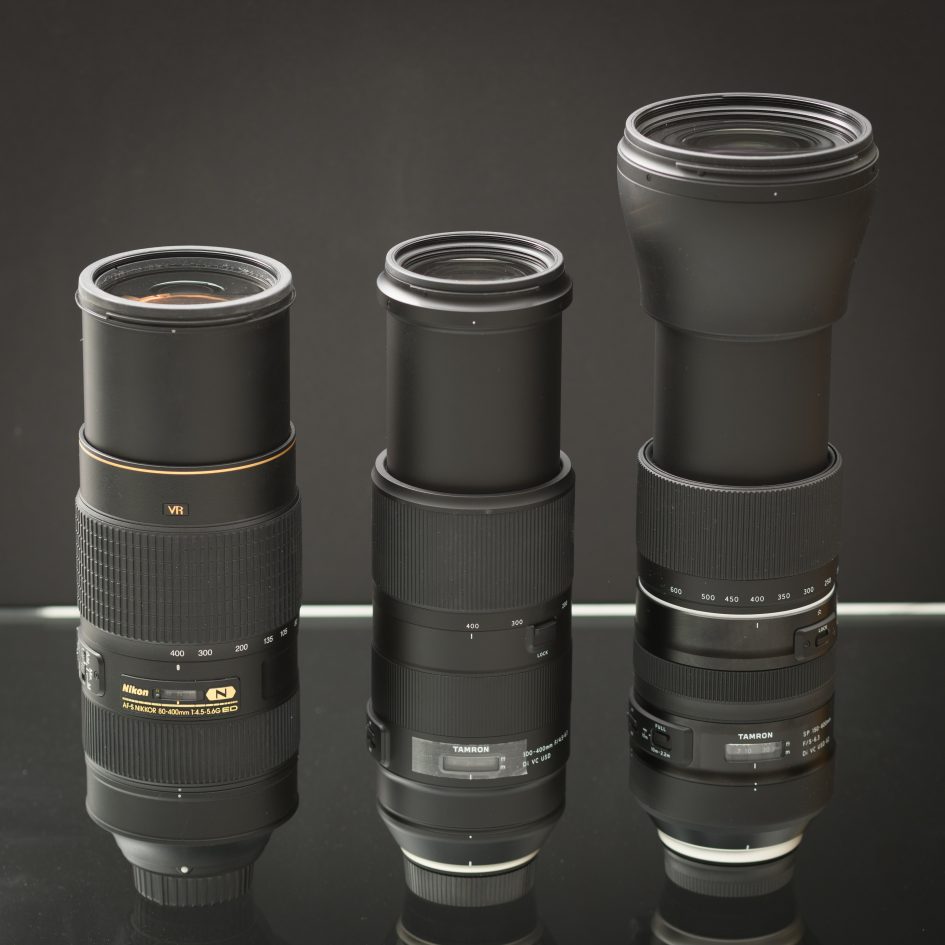
Here is the angle of view that the new Tamron 100-400mm covers with its 4x zoom:

Above: Tamron 100-400/4.5-6.3 VC coverage on Nikon D850 (FF/FX) body at 100mm (left) and 400mm (right)
Compare this to the 5x coverage of the Nikon 80-400mm:

Above: Nikon 80-400/4.5-5.6G VR coverage on Nikon D850 (FF/FX) body at 80mm (left) and 400mm (right)
Focus and zoom
Focus accuracy and repeatability is critical to consistently produce sharp shots. Repeatability (the accuracy of focus on the same subject after repeated focus-acquisition) of this lens at standard settings and 400mm focal length was not up there with the competition: it measured only 91.1% in Reikan FoCal and produced 5 mild outliers over a series of 40 shots. Plus there is some performance variation whether the lens focuses from infinity or from a closer distance. This variability also showed up in real life and led me to inspect every shot for pinpoint focus accuracy: not good! By comparison the Nikon 80-400/4.5-5.6G VR has a repeatability of 98.6%, and had no outliers in 40 shots under the same test conditions.
The focus ring has no slack/play between its movement and the focus-action and a throw of 120 degrees which is fine for manual focusing. Its rubberized surface is 27mm wide. The zoom ring has a 43mm wide rubber surface and turns through 135 degrees. This makes it hard to fully turn the zoom from 100mm to 400mm or vice versa without readjusting your grip on the ring. Both rings are of medium stiffness. They turn both in the same direction as Nikon users are used to but this is the complete reverse of what Canon does. But at least the models from Tamron, Nikon, Canon, and Sigma (but not the new Sony) have the zoom ring at the front and the focus ring closer to the camera. The Tamron does not show much zoom-creep fresh from the factory. But that is likely going to change with use. So it’s good you can lock the zoom at 100 mm.
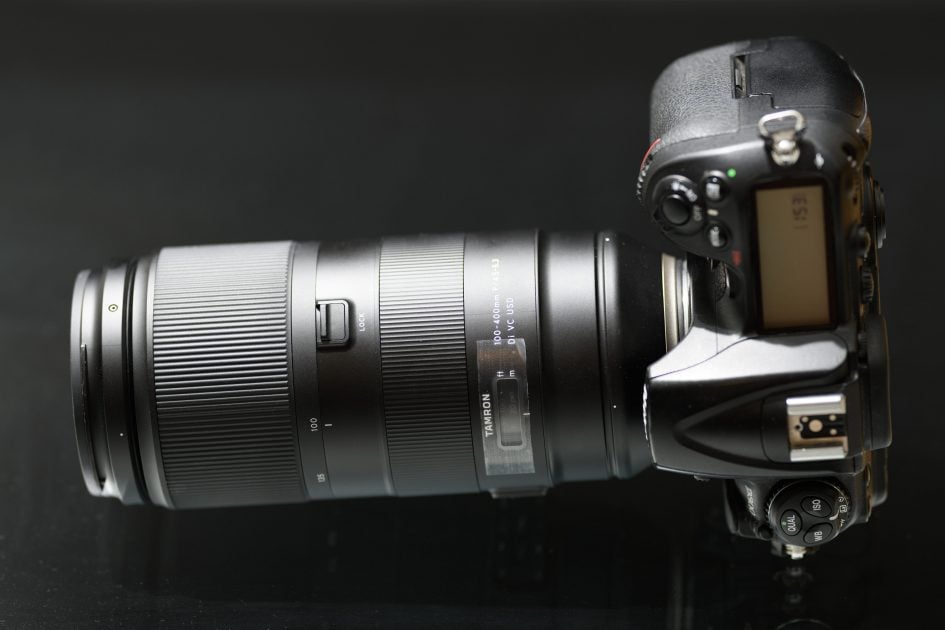
Image stabilization
To test the effectiveness of the image stabilization I did a series of over 500 test-shots hand-held with the new Tamron at 400mm focal length. The Tamron offers customization of their image stabilization: in addition to “normal” VC operation you can choose to put more weight on the stabilization of the viewfinder-image (and consequently shooting video) or to put more weight on stabilization of stills. Unfortunately you can only adjust this with the USB connection via computer as the VC-mode selector on the lens does only switch between non-panning operation (mode 1) or panning operation (mode 2).
I did all my VC tests with priority set to shooting stills. Shutter speeds were from 1/400 of a second down to 1/12 sec. Shots at 1/400 sec with VC=OFF are used as reference of how good my hand-holding was at the time of the test and Reikan FoCal did the chore of evaluating the sharpness of all shots. Here’re the details: down to 1/100 sec (2 stops) the results with VC=On were very sharp with only one or two slightly blurred shots out of 20. At 1/50 sec (3 stops) still 16 out of 20 shots were sharp. At 1/25 sec (4 stops) the chances to get good sharpness is around 1 out of 2 shots and at 1/12 sec chances dropped to 1 in 3 shots. So I’d rate the image stabilization of the new Tamron good for 3+ stops.
AF-operation and image stabilization of the Tamron is barely audible from the outside.
Next check out my quality results, sample images or final verdict using the tabs or link below.
Check prices on the Tamron 100-400mm VC at Amazon, B&H, Adorama, or Wex. Alternatively get yourself a copy of my In Camera book or treat me to a coffee! Thanks!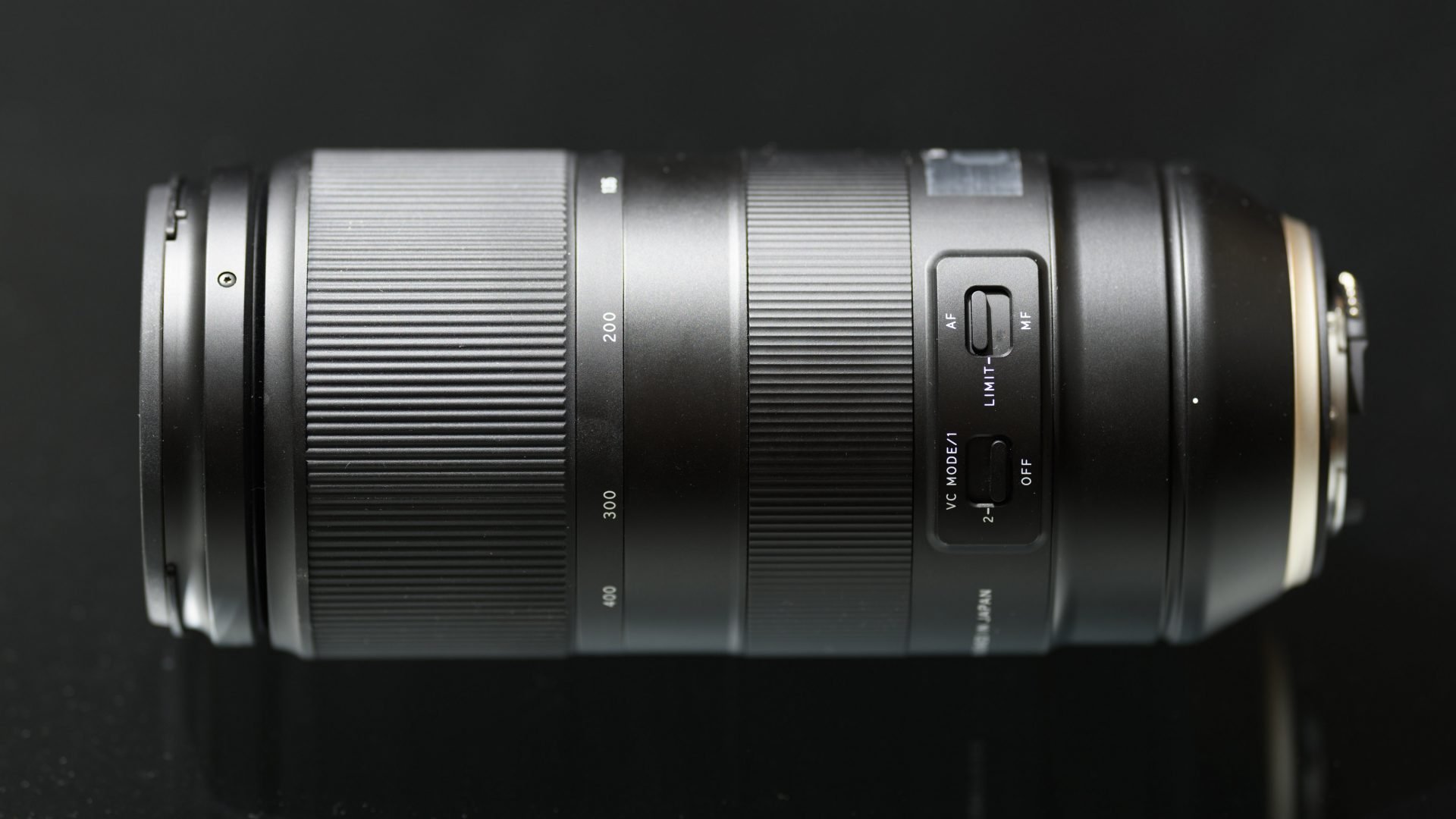
 If you like a light package, have a limited budget, and need the reach of a 400mm telephoto zoom, the new Tamron 100-400mm is a good choice: it may not be as cheap or small as the Sigma 100-400mm but it is the lightest modern zoom reaching 400mm and produces very sharp images - if the focus is nailed right. Because its biggest let-down is the somewhat disappointing AF performance: it produces more outliers than other lenses I've recently tested - at least on my copy. But all-in-all the Tamron 100-400/4.5-6.3 VC certainly earns a recommendation.
If you like a light package, have a limited budget, and need the reach of a 400mm telephoto zoom, the new Tamron 100-400mm is a good choice: it may not be as cheap or small as the Sigma 100-400mm but it is the lightest modern zoom reaching 400mm and produces very sharp images - if the focus is nailed right. Because its biggest let-down is the somewhat disappointing AF performance: it produces more outliers than other lenses I've recently tested - at least on my copy. But all-in-all the Tamron 100-400/4.5-6.3 VC certainly earns a recommendation.



